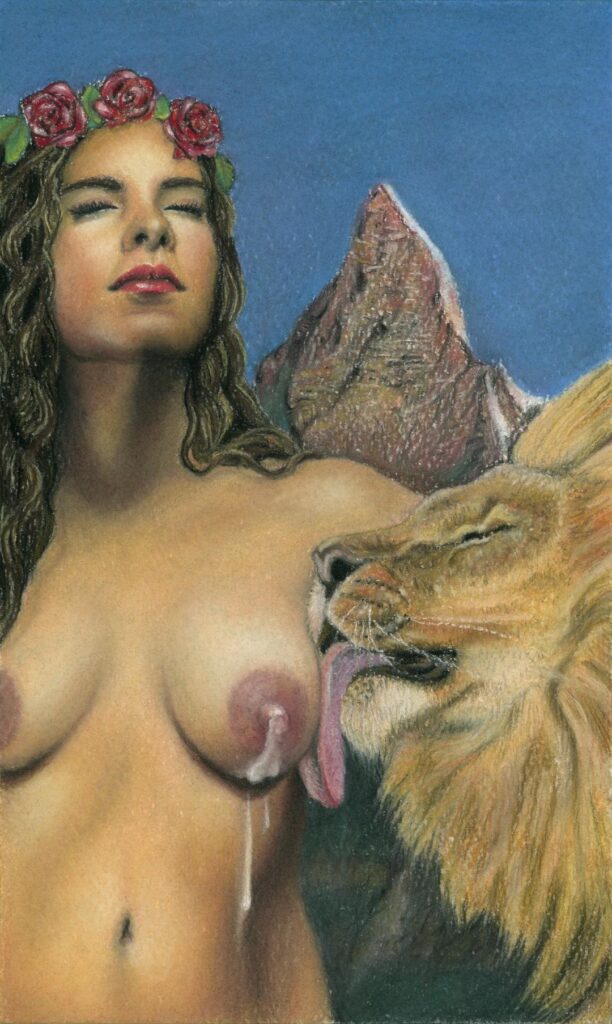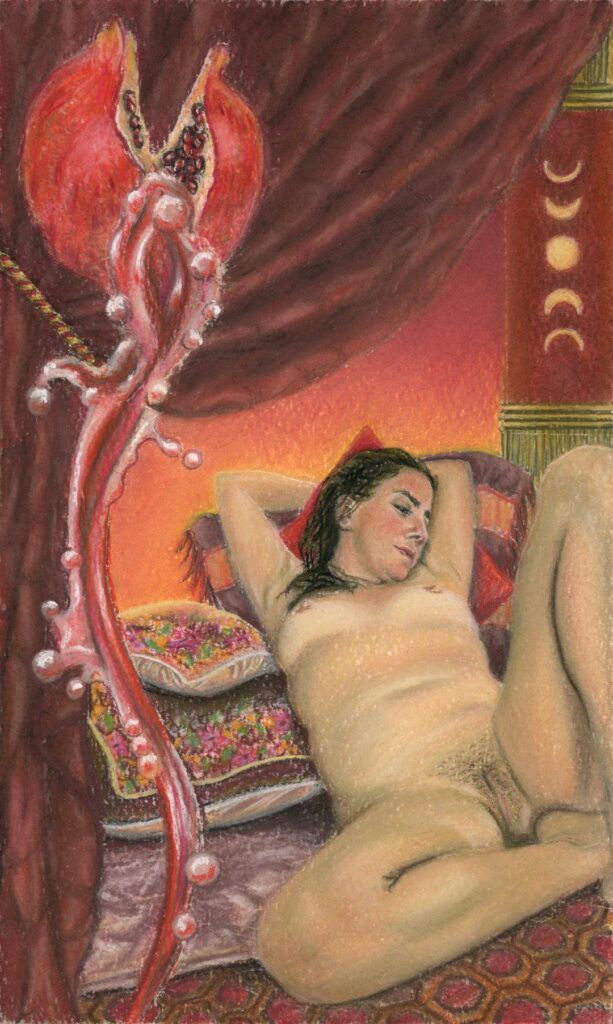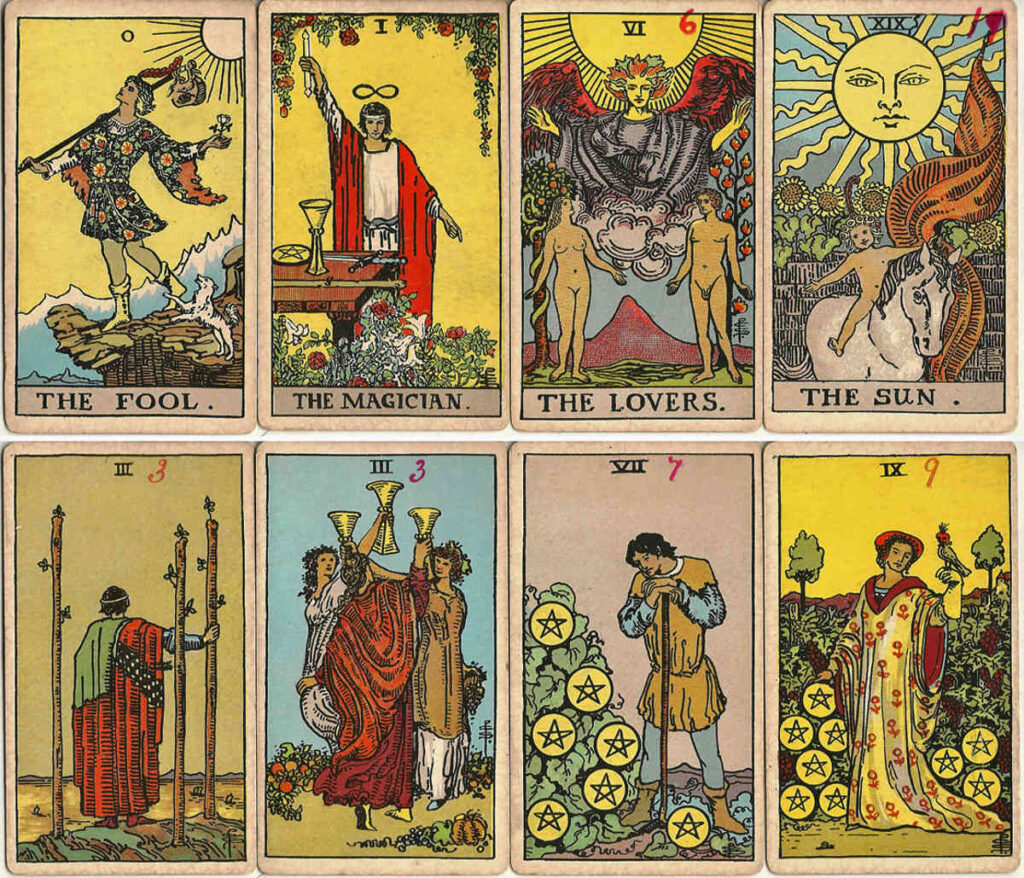Amy Smith-Young is an illustrator. In collaboration with her brother Grant, Amy is re-envisioning tarot deck imagery. Her contemporary, female figures engage Divine Feminine principles and connects the tarot reader with figures relevant to our times .
.
Resources for this episode include the writings of Mary K. Greer and Seeds of Initiation website. Image credits: Seeds of Initiation
Images highlighted in this episode include the tarot cards, “The Empress,” “Strength” and “The High Priestess.”


Below are images from Rider Waite Tarot Deck.

Script: Hello my Art Enthusiasts—Before we journey through the visual imagery expressed in tarot cards through the artist and illustrator Amy Scott-Young, I want to first express my deep gratitude to two new supporters
Special shout out to artist Deborah Wasserman and her support of Beyond the Paint podcast through Patreon. She is a member of the Howardena Pindell tier which offers her the opportunity to choose a future guest on my podcast—She connected me with a female gallery owner and author, Bridgette Mayer. I am looking forward to collaborating with Bridgette in an upcoming episode. Deborah was a recent guest on my show on Episode 130: Migrant, Land and the Feminine Body—I hope you will check her prolific body of performance works, collage and paintings—she also writes poetry. Thank you Deborah! I also want to send a heartfelt thanks to Bob Leo for his generous support of Beyond the Paint podcast and my upcoming art talks and tours. I met Bob when I was working in Education at the New Britain Museum of American Art—he enrolled in the museum’s Docent program and has volunteered at the museum for many years. He is also a very generous benefactor at the William Benton Museum of Art at the University of Connecticut—he supports exhibitions and preservation of their fabulous and extensive collection of Reginald Marsh works. Grateful to you both!
Amy Scott-Young is an artist and illustrator who resides in Australia. Because of geography (I live in the United States) and the time change Amy and I were unable to record a conversation together, however, and this is wonderful news, Amy sent me mini-recordings sharing aspects of her work—they will be incorporated into the show. Thank you Amy—our audience will be able to through this audio experience hear first-hand the nuances and depth of your visual imagery.
Today, we will focus on her current work; she is the illustrator for Seeds of Initiation tarot card deck. The Seeds of Initiation is a collaborative with her brother Grant. Together they are realizing a vision to create a tarot deck “devised and designed based on more than a decade long of Grant’s self-discovery and insightful writings centered on the spiritual. In the podcast notes I will add a link to a video he produced that shares his journey, Amy also uploaded a video on their website sharing some of her personal journey—it is very candid. Grant experienced, personal traumas like bullying, losing jobs, poor relationships, and his sister also shares and expresses similar life challenges, but what is so heartwarming and inviting is both carry this deep joy and are navigating ways to see the world and move through it from a position of compassion and curiosity—they are seekers. Their art and their writings are manifested visually in Seeds of Initiation tarot deck. I asked Amy to further share the role her brother and partner plays in the imagery for the cards. From her answer you will also learn more about Amy’s life experiences and desires to create a deck with a more “humanistic story” free from patriarchy. Let’s listen. Question 4 (What role does your brother and partner play in the imagery for the cards?)
First a confession—I know very little about tarot cards or their history. In crafting and producing podcast shows I am a Maker—I relish this role because I can engage and “teach” others about women, visual arts, art history—this extends to my conversations with artists, my deep dives into their works, their practice, in the context of art history and other historical perspectives. My work as Maker also serves me as a Maven, a maven is someone with expertise in an area—my life is an immersion, of learning and being curious and through the role of being the learner, I satisfy an aspect of my life. It is this beautiful marriage that follows me in all my roles—educator in the classroom, leading art talks for museum programs, this podcast, and the book I am currently writing. And in other aspects of my life—deep interest in Stoicism, Nature, Poetry. I share this with you because it is in this space I feel so aligned with the creators and makers of Seeds of Initiation tarot deck.
The approach I would like to take in this episode is for us to look at the history of tarot cards and the tarot system and to eliminate any misunderstandings you may have—and there are certainly inaccuracies which I am not going to delve into here, in part, because I want to use the bulk of our time journeying through the visual imagery and interpretation of the tarot deck figures and scenes through the lens of Amy Scott-Young.
Special thanks to the writings of Mary K. Greer for resources that helped me this novice become more informed.
Here you go! A condensed history of tarot cards and the tarot system.
Tarot originated sometime between 1420 and 1440 in Northern Italy amid other experiments in creating a suit of triumphal cards—triumphal cards are used for games, fortune-telling and divination. Divination in the context of tarot is “the process of reading patterns and signs to indicate the future. It is the practice of discovering what will happen in the future.” We also know fairly precisely what the images signified in the “High Gothic” to early-Renaissance Italian culture. Here the author is referring to “allegorical imagery from the period. At first the playing cards were hand painted and rare but after the invention of the printing press were mass produced.
Playing cards appeared in Europe and spread quickly about 60-75 years before the Triumphs were added to the deck. For the first 350 years ‘Il Trionfos’ were known almost entirely for playing games similar to whist or bridge as attested to by several frescos and text references.
While there are are rare indications early on that both playing cards and tarot were used for divination and character delineations true “reading” practices were not widely known until the late 18th century. The Frenchman Jean-Baptiste Alliette (Etteilla) wrote a book on how to use tarot cards for divination and issued a set of cards. He called the book L’art de lire dan les carts—translates to The Art of Reading Cards. Alliette established tarot divination as a popular pursuit for the first time. He divined using a deck of just 32 cards with the addition of his own special card, known as the significator which usually represented the person consulting the tarot reader.
As fascination with the occult grew in the 19th century people increasingly used the tarot for divination. Each card had a set meaning which altered if that card was inverted when laid out.
In 1917 the first American tarot book “The Key to the Universe or a Spiritual Interpretation of Numbers and Symbols” is illustrated with Rider Waite Smith decks—the imagery, the themes and structures, from those decks do come to play in Amy’s illustrations for Seeds of Initiation. “The classic Rider-Waite Tarot is the best known Tarot deck. The vibrant cards (and they are—strong use of vivid colors) feature full scenes with figures and symbols drawn in 1909 by a female illustrator Pamela Colman Smith under the direction of Arthur Edward Waite.” (tarot.com)
Amy’s illustrations of women for the Seeds of Initiation Tarot deck, though informed and inspired by the Rider Wait Smith tarot deck are modeled after contemporary women. As Amy shares in this clip her inspirations extend to a broad range of sources. Question 1—Where does inspiration come from?
She did note in an email exchange: “In relation to any other art sources that inform my work, I don’t really have any aside from the original Rider Waite Smith tarot deck. I’m fascinated by the alchemical engravings in Athansius Kircher and Michael Maier’s works (both of the 17th century). I am more inspired by my reading and research though more than anything else.”
She also points out, “I am purposefully creating a Tarot experience that is more relevant to the people of our time.” From Amy, “I had a huge shift in early adulthood when I rejected the religious conditioning of my childhood and started to explore the Tarot. The colour palettes and whimsical imagery of more modern decks resolved my desire to be surrounded by beauty — engaging in tarot readings she goes on to say that tarot decks like Rider Wait Smith fulfilled my need to gain a greater understanding of the world around me; it is largely through self-reflection and observation but also through the wealth of knowledge accumulated throughout the ages.
The illustration that grabbed me initially is the card “Strength.” Pictured is a young woman, her flowing light brown hair is crowned in a wreath of three red roses. She is nude, we can view her body from the waist up, her ample breasts exposed. To her left is a regal looking lion, we see him in profile, his eyes tightly shut, his generous tongue is slurping the milk expressed from one of her breasts. The woman’s eyes are also closed—it is as if they adopting from each other aspects of their characters, their emotions. Behind the figure and lion is a grey mountain top—the edge of its precipice pierces the bright blue sky.
The High Priestess card is a woman, completely nude reclining on tufted patterned pillows atop a patterned rug. A curtain, rich in textured autumn red is pulled back to fully reveal the woman, relaxed, her arms are behind her head, her legs, one bent, the other is tucked close to her body—her (vagina) is exposed. Her face is turned away from us, she looks deep in thought, unaware of her nakedness or our gaze.
The Empress is another reclining woman, she is shrouded in a burnt orange drapery that exposes her hard round belly as she is giving birth—we can see the crown of the baby’s head navigating through her parted legs, surrounding her is very large, ripe pomengranite, split open to reveal its plumb seeds. The woman’s eyes, like in Strength are closed, but not in a blissful expression—we see her in the pains of labor as she breathes new life through her.
All three women are fully nude or as in the Empress, partially nude. I asked Amy, Question 2: Why the nude figure? I so admire Amy’s ability to be self-reflective and to view the female figure and experience through a multi-dimensional lens. Bravo
I asked Amy What connections do you hope the tarot card reader will make with the images of these women? Is it your hope the tarot reader will see herself or aspects of herself in your illustrations of women, like in the image Strength, High Priestess, The Empress Question 3
Seeds of Initiation tarot deck is a visual, divination tool to connect the reader with Divine Feminine Principles within the physical body of a woman—that is so powerful. Through Amy’s imagery we can truly look inward, to connect with spirit, as Amy notes, “to bless and take care of our bodies and have gratitude for all its divine potentialities.” Thank you for listening. I encourage you to explore and learn more about the collaboration of visual imagery and spiritual in the Seeds of Initiation tarot deck. Resources for this episode are listed on my website beyondthepaint.net I added links to Amy and Grant’s website and their IG handles in the podcast notes. Thank you
